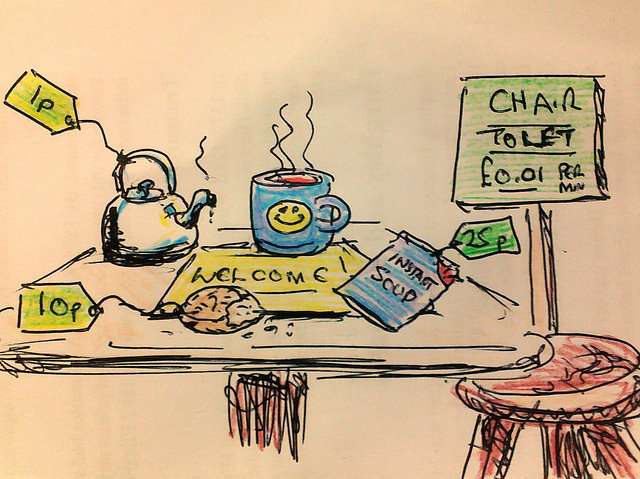This week I heard Helen Southgate, the MD of affilinet UK, speak at a performance marketing conference and say;
If affiliate networks don’t change they will gone in five years.
This isn’t another ‘death of’ post. The performance marketing sector is a £14 bn growth area.
There are pressures, though, and Helen isn’t wrong to urge change. I doubt anyone inside the industry would argue that there are no common demands that networks, agencies and in-house teams face.
One of those common issues is the feeling that there is untapped value in the large number of content affiliates available and a frustration this value is hard to reach.
Today, the affiliate landscape is dominated by coupon sites, cashback sites and a few significant PPC, remarketing and email affiliate activities. Given the importance of coupon and cashback it makes sense that the affiliate networks have invested in technologies and methodologies to work with them.
Content sites are a challenge. They’re often blogs or forums. They’re often run by hobbyists who rarely check emails from brands or network communication teams. These sites are often small. They are the long tail.
If the pressure to do more with content sites increases then the good news is that there is more affiliate networks can do. Here are a few ideas.
#1. Buy tenancy

A tenancy deal is a flat rate purchase of space on a content affiliate’s site. This is usually in addition to the CPA deal the affiliate is on and therefore a challenge for in-house teams or agencies to get sign off on.
However, affiliate networks could set aside a sum of cash to buy tenancy on a number of carefully selected content sites and then use that space as they need.
A little bit of technology would allow the affiliate network to swap and change the ad units shown, the busy content affiliate would not need to work any harder and the affiliate network would be in a position to quickly put resources behind campaigns that need a push.
This approach is common among video seeding platforms.
#2. Provide better ad serving

The way in which affiliate networks provide ads is still pretty basic. Site owners are left to copy and paste JavaScript (or flat HTML) to show just one banner. Sure, yes, some affiliate networks provide better content matching and updates but they’re far from sophisticated.
It would be far better to offer content affiliates a fully-fledged ad serving platform. The affiliate network’s system would let the affiliate set serving rules:
- Serve any ad from a group of brands that is less than ____ weeks old.
- Serve any ad from a group of brands that has an EPC (earning per click) of at least ____
- Serve any ad from a group of brands with a commission of at least ____
- Serve any ad from a group of brands once activated with a tenancy of ____
This system could even extend into CPM. After all, affiliates are approved by hand and often with more scrutiny than publishers on small display networks.
- Serve any CPA ads from a group of brands if no CPM offers greater than ____
- Serve CPA ads from a group of brands if eCPM exceeds CPM offers.
When I say ‘group of brands’, that could be all merchants the affiliate works with or a custom group built by the affiliate.
The opportunity for this grand project is now. Open X retreated from their free ad serving platform and sadly Adzerk is phasing out its too. The gap in the market is about to open.
#3. Build a content affiliate collective

Affiliate networks could maintain a custom list of active and quality but not necessarily large content affiliates.
This list could then be used to allow merchants to communicate with the affiliates with headline ideas, news, offers and other content-centric opportunities.
The promise of quality makes such collaboration a temptation. Affiliates would appreciate curated access to brands willing to work with them on content terms.
Brands would appreciate vetted content affiliates willing to work with them with content.
#4. Video

Affiliate networks do very little with video. This is a shame.
The technology to put a clickable layer on top of a YouTube embed is there. This would mean all those content sites that make good use of YouTube or even Vimeo could turn those embeds into an ad space.
Recently one of the pioneers in this space, Coull, stepped away from enabling sites with less than 500,000 video plays per month. Affiliate networks can cope with the bandwidth, don’t need to host the video (ideally; shouldn’t) and have no need to charge an extra on-boarding fee to their merchants. They could do what Coull couldn’t.
#5. Product alerts

I am a content affiliate. I have a Google Calendar which reminders to go check specific retailers to look for new products matching the niches I write about.
What a pain. It would be much better if the affiliate networks, with their product feeds, would let me enter keywords/topics that I want a heads up about.
For example, I’ve a geeky blog that writes about superheroes. As a content affiliate I look out for retailers who bring out a range of stylised superhero t-shirts so I can blog about the design and affiliate link to the purchase page.
It would be a win-win-win if the affiliate network technology let me know the instant superhero t-shirts became available via one of my approved merchants.
#6. Content promotion

Affiliate networks make money when affiliates do. To support content affiliates networks could set aside a (relatively small) budget to spend on companies like Outbrain, StumbleUpon and Taboola to promote those instances of very high quality content when they are created by affiliates.
Yes, but ads to promote your affiliates.
Imagine this strategy working in conjunction with suggestion number three, ‘content affiliate collective’. Content affiliates would have to meet a certain quality and closeness of relationship with the network to quality for this boost.
#7. Buzz alerts

The link shortening service Bitly runs RT.ly as an experiment. The platform reveals which bit.ly links are getting the most clicks in real time. Content bloggers use it to see what the hot story is right now as a way to discover what they should be writing about right now.
Affiliate networks are in a similar position to Bitly. The networks could provide real time insight or even alerts when product and service pages receive a boom in traffic.
This insight could well be incredibly valuable to content affiliates in search for a timely and monetisable topic.
#8. Content exchange

Some of the largest ‘magic middle’ blogs make heavy use of content exchanges like ZergNet and Crowd Ignite. These platforms are responsible for making recommendations to readers and balancing the traffic those generate around their publishers.
Content exchanges are often controversial and often not pretty. They usually have an annoying middle page which attempts to lure a few extra clicks out of the reader and may even sneak in a pop-under. Some advertisers won’t work with sites that deploy them.
Affiliate networks are in an interesting position. The networks could run a content exchange in such a way that it benefits the content affiliates on it while not needing to extract those extra clicks by interrupting the reading experience.
Imagine the content exchange idea running in conjunction with the first suggestion of buying tenancy.
#9. Curate content

With an investment of time rather than any new technology an affiliate network could create a content curation brand to be active on Twitter, Facebook or Google+.
There they share the best content created by their affiliates on any given day. By doing so and through some digital marketing these branded curation entities would earn an audience and help amplify the efforts of their content affiliates.
For example, an affiliate network could run a Twitter account that shared a few travel tips every day. By picking good examples and taking part with the Twitter and travel communities this account easily and with very low cost help to promote the travel content produced by affiliates.
#10. Go contract hardball

There are negotiations between brands and agencies when an affiliate program is signed up. Agencies and experienced in-house teams have every financial reason to try and push the network price down as far as possible. Working with content affiliates is an opportunity for networks to push back.
Networks could insist that agencies and in-house teams commit to a certain number of events (outside of London and New York) a year, a number of Q&As with significant names within the brand (aka content), a number of scoops, high quality product photos and other content creating offers.
The challenges
I’m sure there’s a mix of good and bad ideas in this list of 10 things. I think it also worth repeating that content affiliates are not the big earner for networks and this likely why no network has the lead on any content initiative.
It’s also true to say that content affiliates have alternatives. Skimlinks and Google backed VigLink are increasingly the first stop for blogging affiliates. These two services sit between the networks and publishers and provide automation and tools. Skimlinks provides a toolset to writers and bloggers to help boost the value of their content. Both sites have far more brands on board than any single network does.
The last and most significant problem affiliate networks face in this challenge is that content affiliates are not very good at stepping forward and saying what they need. The exception, of course, is lucrative tenancy deals. I’d argue that such deals are becoming better known as native advertising but that’s a whole other topic for the industry to address.
Extracting the value from the fragmented long tail of content sites will be awkward and I suspect controversial too. I have to wonder whether content affiliates become the shale gas of the performance sector. Fracking content affiliates.
Image credits; creative commons various.























No Comments